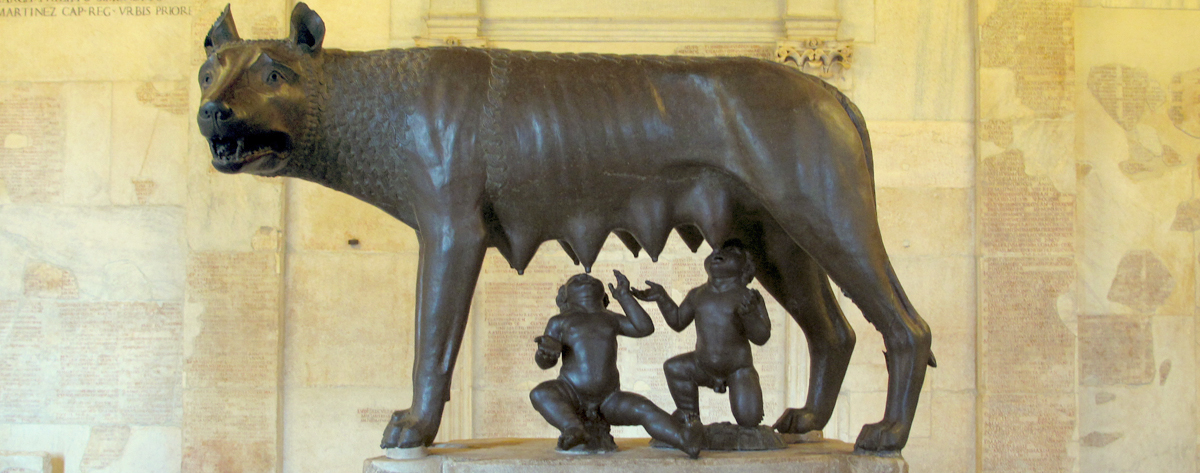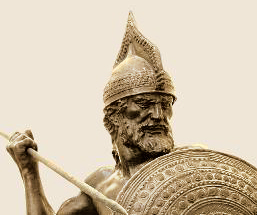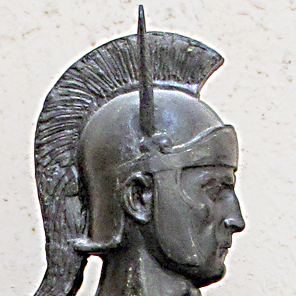The ROMAN CIVILIZATION
IMAGES OF THE ROMAN CIVILIZATION
THE HISTORY OF ROME
spans 2,800 years of the existence
A city that grew from a small Italian village in the 9th century BC into the center of a vast civilization that dominated the Mediterranean region for centuries. Its political power was eventually replaced by that of peoples of mostly Germanic origin, marking the beginning of the Middle Ages. Rome became the seat of the Roman Catholic Church and the home of a sovereign state, the Vatican City, within its walls. Today it is the capital of Italy, an international worldwide political and cultural centre, a major global city, and is regarded as one of the most beautiful cities of the ancient world.

According to the founding myth of Rome, the city was founded on April 21, 753 BC by twin brothers Romulus and Remus who descended from the Trojan prince Aeneas and were grandsons of the Latin King, Numitor of Alba Longa. King Numitor was deposed from his throne by his cruel brother Amulius while Numitor's daughter, Rhea Silvia, gave birth to the twins. As Rhea Silvia was raped and impregnated by Mars, the twins were considered half-divine.
The new king feared Romulus and Remus would take back the throne, so they were to be drowned. A she-wolf (or a shepherd's wife in some accounts) saved and raised them, and when they were old enough, they returned the throne of Alba Longa to Numitor.
The twins then founded their own city, but Romulus killed Remus in a quarrel over which one of them would reign as the King of Rome, though some sources state the quarrel was about who was going to give their name to the city. Romulus became the source of the city's name. In order to attract people to the city, Rome became a sanctuary for the indigent, exiled, and unwanted. This caused a problem for Rome which became rich in manpower but was bereft of women. Romulus traveled to the neighboring towns and tribes and attempted to secure marriage rights but as Rome was so full of undesirables they all refused. Legend says that the Latins invited the Sabines to a festival and stole their unmarried maidens, leading to the integration of the Latins and the Sabines.
 Another legend recorded by Greek historian Dionysius says that Prince Aenas led a group of Trojans on a sea voyage. After a long time in rough seas, they landed at the banks of the Tiber River. Not long after they landed, the men wanted to take to the sea again, but the women who were traveling with them did not want to leave. One woman, named Roma, suggested that the women burn the ships out at sea to prevent them from leaving. At first, the men were angry with Roma, but they soon realized that they were in the ideal place to settle. They named the settlement after the woman who torched their ships.
Another legend recorded by Greek historian Dionysius says that Prince Aenas led a group of Trojans on a sea voyage. After a long time in rough seas, they landed at the banks of the Tiber River. Not long after they landed, the men wanted to take to the sea again, but the women who were traveling with them did not want to leave. One woman, named Roma, suggested that the women burn the ships out at sea to prevent them from leaving. At first, the men were angry with Roma, but they soon realized that they were in the ideal place to settle. They named the settlement after the woman who torched their ships.
a period of over two hundred years
CLICK ON NAMES FOR MORE INFO
Romulus
The first recognized king of Rome was its mythical founder, Romulus. To him is attributed the foundation of the senate. He is also said to have ruthlessly pursued a policy of expanding the population, granting refuge and acceptance to criminals on the run at the asylum on the Capitoline Hill. He expanded the city’s boundaries to encompass four hills; Capitoline, Aventine, Caelian and Quirinal. If Romulus’ reign was infamous, this impression is only further reinforced with an episode widely known as the ‘Rape of the Sabine women’.
Numa Pompilius
To the Romans King Numa Pompilius was the father of their culture; the man who turned the semi-barbarian peasants, criminals and bride-robbers of Romulus into something resembling a civilization.
Modern historians are not sure what to make of this figure.
Some priesthoods he is said to have created are believed to predate his reign. Meanwhile his supposed reform of the calendar was possibly the achievement of a later generation.Nonetheless, the high esteem in which the Romans held this figure, suggests that he was of great significance in the creation of their identity as a people.
Tullus Hostilius
With the death of the peaceable Numa Pompilius rule next fell to the warlike Tullus Hostilius. In these primitive days of early Roman history many of the disputes arose from mundane issues such as cattle rustling along territorial borders.
Numa Pompilius had been a diplomatic man who would seek to achieve reconciliation. However, his successor Tullus Hostilius was a man who would seek to solve problems by the sword.
When another such dispute arose between Rome and its neighbour Alba Longa, Tullus Hostilius declared war. Given the very close ties between the two cities, this was a virtual civil war. Therefore, in order to avoid slaughter between armies related to each other, the two leaders Tullus Hostilius and Mettius Fufetius agreed instead on a contest of champions. Three brothers from each side would fight in place of the armies.For the Romans the brothers Horatius took the field and for the Albans the brothers Curiatius. The fight ended with all Curiatii dead and only one of the Horatians alive.
The Roman victory meant that Alba Longa conceded defeat and swore allegiance to Rome.
King Mettius however had no intention of accepting Roman supremacy and succeeded in provoking another
Roman neighour, the Fidenates, into war. When the Romans met the Fidenates in battle their supposed Alban allies abandoned them. Mettius Fufenius’ though proved plans were in vain. Rome defeated the Fidenates on her own. The Albans were soon crushed, their leader torn apart by two chariots and the city of Alba Longa was destroyed. The Albans were thereafter moved to Rome where they were given the Caelian Hill to settle on.
This increase in population made the senate’s meeting place too small to contain the enlarged senate. Tullus Hostilius therefore decided a new senate house was needed. It was constructed at the western end of the Forum at the foot of the Capitoline Hill. It remained there throughout Roman history and continued to bear its builder’s name, the Curia Hostilia.
Tullus Hostilius is said to have thereafter campaigned successfully against the neighbouring Sabine tribes, until a plague befell him as well as the people of Rome, forcing them to make peace.
In seeking to avert the wrath of the gods, Hostilius now sought to emulate his predecessor and took greater interest in his religious duties.
Yet his new found religious devotion fell well short of having the desired effect. King Tullus Hostilius was struck lighting and died.
Ancus Marcius
Rome’s fourth king was Numa Pompilius’grandson and therefore another Sabine. Ancus Marcius was chosen as a ruler to restore the peace and quite the Romans had enjoyed under the rule of his grandfather. This in turn gave Rome’s neighbours the impression that the city’s new leader was a pushover, eager for peace at any price and therefore unlikely to retaliate. The first to test this premise were the so-called Old Latins (prisci latini), an ancient tribe who even predated Aeneas.
Yet king Ancus Marcius, perhaps to everyone’s surprise, proved to be as much of a warrior as he was an administrator, priest and diplomat.The prisci latini were defeated, their city destroyed and their people absorbed into Rome.Ancus Marcius is also said to have settled the Aventine Hill. Given this new influx of people, this may indeed
As with Tullus Hostilius, King Ancus Marcius does have much later descendants make an entrance into the Roman records. By 357 BC the Marcii reached the consulship.
Again this suggests the existence of this ruler of Rome’s semi-mythical history may indeed have existed.
Tarquinius Priscus
The fifth king of Rome was one Lucius Tarquinius Priscus (Priscus in this case simply signifies him as Tarquin ‘the Elder’ and it was a title attributed to him much later by Roman historians). The stories surrounding this monarch show us that we are still deeply reliant on legend and myth to paint any sort of picture of his rule. Tarquin the Elder, as Tarquinius is generally called, moved to Rome from the Etruscan town of Tarquinii. His father, Demaratus, was a nobleman from Corinth who was forced to leave his city (655 BC) when the tyrant Cypselus assumed power there.
The link to Greece is indeed possible as there is evidence of Greek traders in Tarquinii. But it nonetheless sounds like a somewhat strained effort by later Romans to avoid admitting that Rome had in fact been ruled by Etruscans.
Legend has it that on his entering the city of Rome an eagle swooped down and snatched Tarquin’s cap with his talons, only to place on his head again before flying away. Evidently Tarquin was a man favoured by fate. Nontheless he deemed it wise to change his forename from the Etruscan Lucumo to the Latin Lucius in order to smooth his transition from Etruscan to Roman nobility. Tarquin’s wife Tanaquil was of aristocratic Etruscan blood.If by his own right, or by that of his wife’s connections, Tarquin soon rose to be a figure of significant influence in Rome.
He further assumed an influential position with the reigning king, Ancus Marcius. So much so in fact, he was made guardian of King Ancus’ two sons.
This proved a position of vital importance when Ancus Marcius died.
Servius Tullius
The sixth king, Servius Tullius, was a monarch celebrated for particularly high achievement by the Romans. Yet to modern eyes, it appears as though several achievements of early Roman history have somehow been attributed to him as a means of attributing them to someone. For it seems doubtful that Servius was really responsible for all ascribed to him.
His position though was soon secured, when a war against the Etruscan city of Veii proved him to be an able military commander. In fact so impressive was his victory that in his 44 years in power he had no need to take to the field again.
The Romans believed Servius’ reign to have seen the first use of coinage in the city.
Unlike the Greeks, early Roman society did not use money. Far more they bartered - salt for pottery, grain for wood, etc...
Where the system proved inadequate the Romans expressed value in for of 'heads of cattle'. One such head of cattle was worth ten sheep.The head of cattle (pecus) became the first Roman monetary unit. From this came the first Latin word for money - pecunia. A primitive monetary system evolved based on ingots of raw copper of the Roman pound (libra) of 327 g.Such an ingot could then be broken up into yet different sizes and values.
King Servius was the first to have a stamp put onto the copper, until then it was just the raw metal. The design to have been used supposedly was either an ox or sheep.
King Servius Tullius is said to have enlarged the city. Romans also attributed the ‘Servian Wall’ to him, though it is most likely that he was this city wall was a product of the 4th century BC
Lucius Tarquinius Superbus
The seventh and final king of Rome was one Lucius Tarquinius Superbus (Superbus in this case simply signifies him as Tarquin ‘the Proud’ and it was a title attributed to him much later by Roman historians). Tradition holds that Tarquin ‘the Proud’ was the son of Tarquin ‘the Elder’, though logic suggests that he more likely was a grandson. (Tarquin the Elder died in old age, his successor, Servius Tullius ruled for 44 years and Tarquin himself ruled for another 24/25 years.)
If Tarquin governed Rome as a petty, sometimes vindictive tyrant, his performance as a military commander and diplomat was more impressive.He harassed and cajoled the Latin League into accepting Rome as its official head (the so-called ‘Treaty of Ferentia’), thereby tying the Latins into the Roman military machine, effectively doubling Rome’s military power in a single stroke.
This new military power was then put to use against the neighbouring tribe of the Volcians. Two cities were conquered; one by storm, the other, the city of Gabii, by deceit.
A legend of considerable importance which attached itself to Tarquin was that of the Sibylline Books. The story goes that the famous Sibyl, a mythical prophetess known throughout the Hellenistic world, appeared before King Tarquin and offered him nine books, containing great wisdom. The price she demanded was astronomical. Tarquin declined. Unflustered, the Sibyl then threw three of the book sin the fire, only to demand the same price for the remaining six books. Unnerved, Tarquin though again declined only to see another three of the books tossed into the flames. Once more the Sibyl demanded the price. Tarquin relented, if only to save what knowledge was left.
If the Sibyl was legend, the Sibylline Books are indeed thought to have existed, though their origin is unknown. The books were repeatedly consulted for divine guidance in the republican era during times of crisis and were eventually destroyed when fire consumed the Temple of Jupiter Capitolinus in 83 BC.
With the wealthy living in fear of prosecution, should Tarquin deem them a threat or take a fancy to their possessions, and the poor being used to labour in public construction, all Rome have been seething with resentment towards her ruler. When finally revolution occurred, Tarquin was not in the city, but engaged in another military campaign.
The final straw had been the rape of the noblewoman Lucretia by Tarquin’s son Sextus set the city alight. The nobles made their move, led by Lucius Iunius Brutus, declared themselves against Tarquin and instead announced Rome to be a republic (510/509 BC).
The army quickly came over to the rebels and Tarquin the Proud was forced into exile. The early days of the Roman republic saw a bitter struggle for independence against Tarquin’s attempts to regain his throne.
